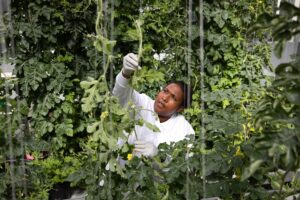By: Megan Poinski
Animal and rare plant proteins grown in crops could be on the market as soon as 2025.
 Since the beginning of agriculture, farmers have grown and cultivated crops to take advantage of their components. Wheat, corn, soy and fruits have been grown to be consumed as they are, processed into traditional ingredients or used as animal feed.
Since the beginning of agriculture, farmers have grown and cultivated crops to take advantage of their components. Wheat, corn, soy and fruits have been grown to be consumed as they are, processed into traditional ingredients or used as animal feed.
In the last several years, new technology has shifted the limits of what can be done with these traditional crops. Companies using a process known as molecular farming utilize bioengineering tools—including CRISPR gene editing and more traditional genetic modification processes— to make traditional crops contain new ingredients on a molecular level. The ultimate goal is to create new, plentiful and more sustainable sources of ingredients that are either difficult to source or face cost or sustainability challenges.
Todd Rands, CEO of the molecular farming company Elo Life Systems, says the process turns common plants into “biofactories.” Basically, he says, companies alter the genes of an easy-to-cultivate plant to produce a chemically identical version of a target ingredient.
 There are no ingredients derived through molecular farming available yet, since companies are in the midst of their own research and development, as well as working with US regulators for approval of their bioengineered plants.
There are no ingredients derived through molecular farming available yet, since companies are in the midst of their own research and development, as well as working with US regulators for approval of their bioengineered plants.
However, if the science and regulatory processes work as expected, companies anticipate that molecular-farmed ingredients could be on the market as soon as 2025.
“All of a sudden, really rare, wonderful ingredients in nature are now available at scale for broad use. [Molecular farming] really unlocks it,” Rands states. “It makes it affordable and accessible.”
“And accessible nutrition is really what we’re aiming for here,” he continues. “How do we get better quality nutrition to more people at an affordable price? That’s what molecular farming can deliver. And that’s why we’re excited about it.”
Read the full article on page 42
